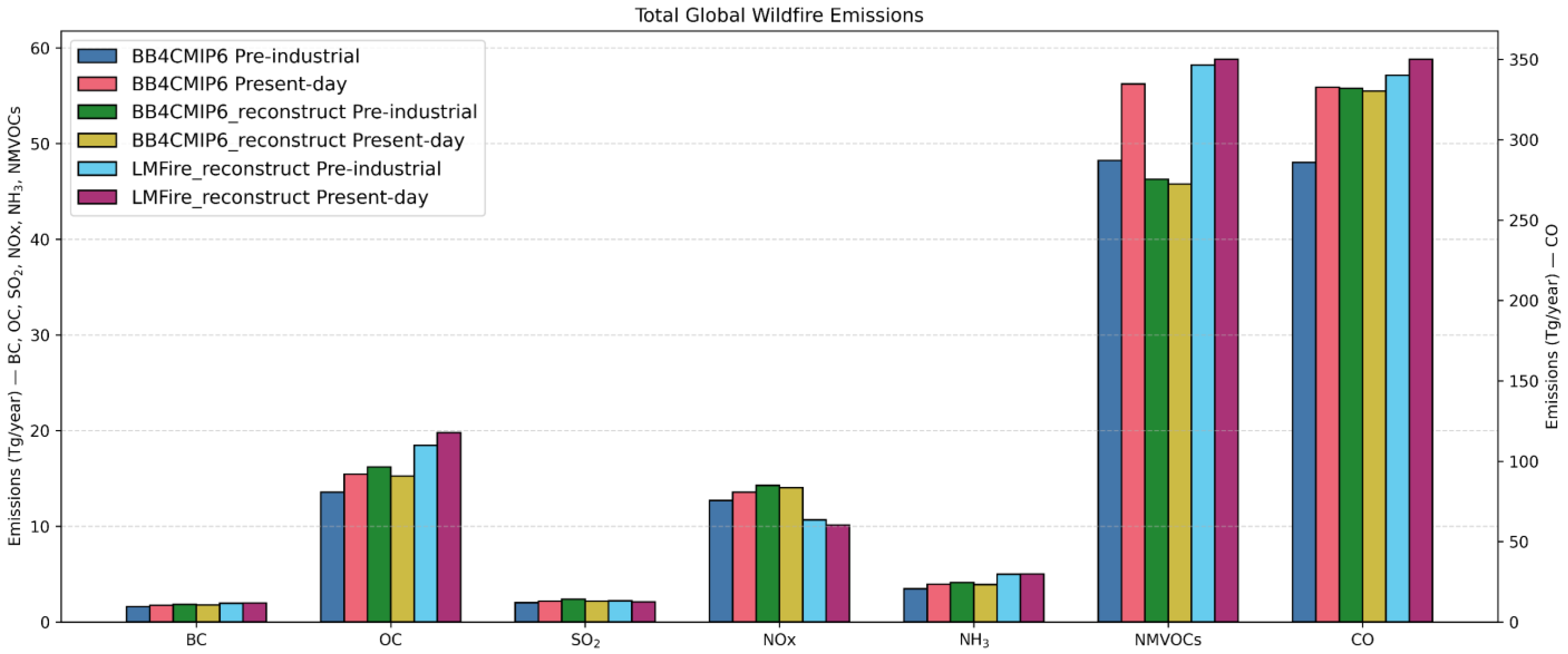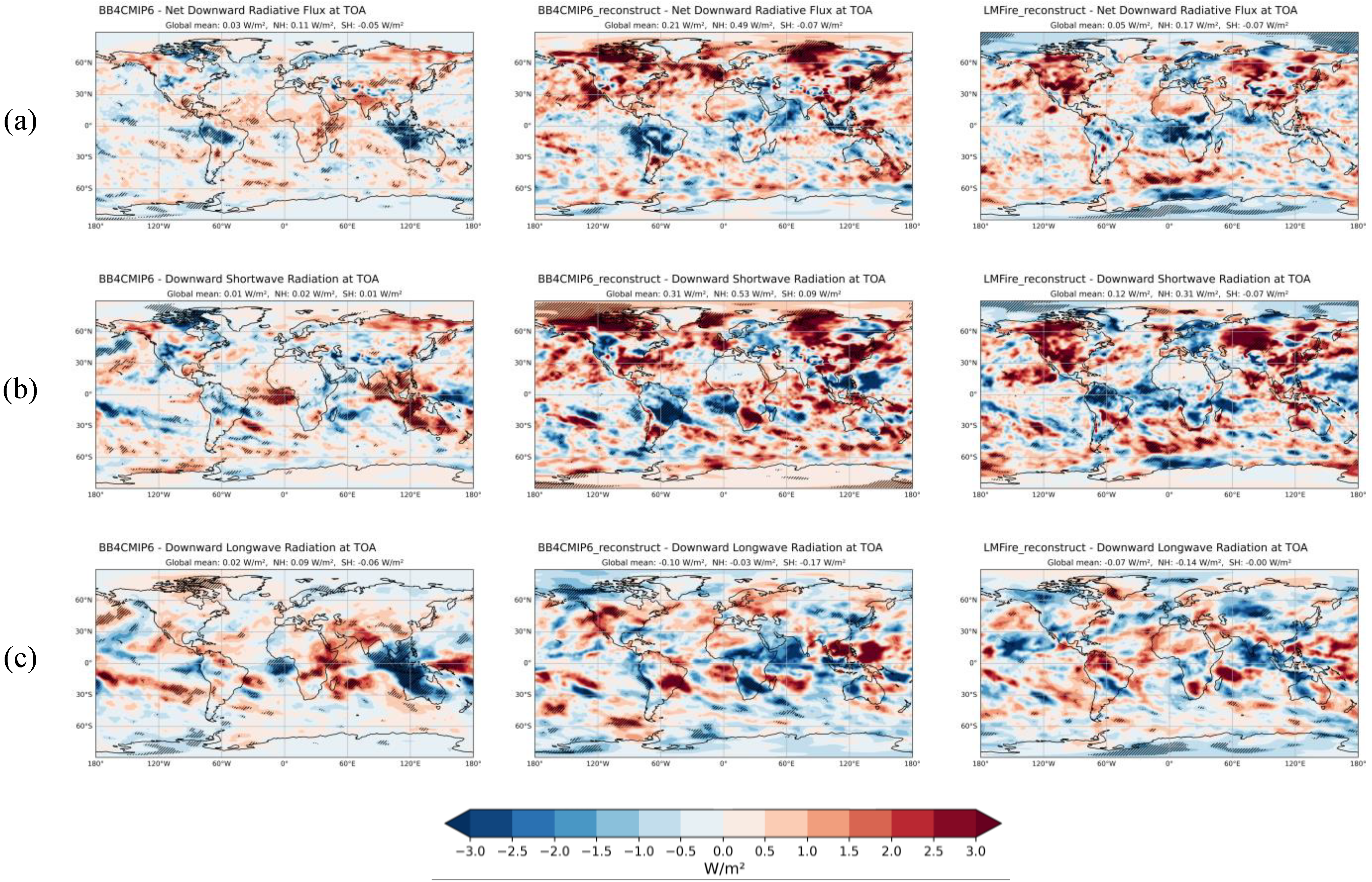Studying the Pre-Industrial to Present-Day Effective Radiative Forcing from Wildfire Emissions Using EC-Earth †
Abstract
1. Introduction
2. Materials and Methods
3. Results
4. Conclusions
Supplementary Materials
Author Contributions
Funding
Institutional Review Board Statement
Informed Consent Statement
Data Availability Statement
Acknowledgments
Conflicts of Interest
Abbreviations
| ERF | Effective Radiative Forcing |
| ESM | Earth System Model |
| SSTs | Sea Surface Temperatures |
| SICs | Sea Ice Concentrations |
References
- Ward, D.S.; Kloster, S.; Mahowald, N.M.; Rogers, B.M.; Randerson, J.T.; Hess, P.G. The Changing Radiative Forcing of Fires: Global Model Estimates for Past, Present and Future. Atmos. Chem. Phys. 2012, 12, 10857–10886. [Google Scholar] [CrossRef]
- Voulgarakis, A.; Field, R.D. Fire Influences on Atmospheric Composition, Air Quality and Climate. Curr. Pollut. Rep. 2015, 1, 70–81. [Google Scholar] [CrossRef]
- Rap, A.; Scott, C.E.; Spracklen, D.V.; Bellouin, N.; Forster, P.M.; Carslaw, K.S.; Schmidt, A.; Mann, G. Natural Aerosol Direct and Indirect Radiative Effects. Geophys. Res. Lett. 2013, 40, 3297–3301. [Google Scholar] [CrossRef]
- Döscher, R.; Acosta, M.; Alessandri, A.; Anthoni, P.; Arsouze, T.; Bergman, T.; Bernardello, R.; Boussetta, S.; Caron, L.-P.; Carver, G.; et al. The EC-Earth3 Earth System Model for the Coupled Model Intercomparison Project 6. Geosci. Model. Dev. 2022, 15, 2973–3020. [Google Scholar] [CrossRef]
- Smith, C.J.; Kramer, R.J.; Myhre, G.; Alterskjær, K.; Collins, W.; Sima, A.; Boucher, O.; Dufresne, J.-L.; Nabat, P.; Michou, M.; et al. Effective Radiative Forcing and Adjustments in CMIP6 Models. Atmos. Chem. Phys. 2020, 20, 9591–9618. [Google Scholar] [CrossRef]
- Forster, P.M.; Richardson, T.; Maycock, A.C.; Smith, C.J.; Samset, B.H.; Myhre, G.; Andrews, T.; Pincus, R.; Schulz, M. Recommendations for Diagnosing Effective Radiative Forcing from Climate Models for CMIP6. J. Geophys. Res. Atmos. 2016, 121, 12460–12475. [Google Scholar] [CrossRef]
- van Marle, M.J.E.; Kloster, S.; Magi, B.I.; Marlon, J.R.; Daniau, A.-L.; Field, R.D.; Arneth, A.; Forrest, M.; Hantson, S.; Kehrwald, N.M.; et al. Historic Global Biomass Burning Emissions for CMIP6 (BB4CMIP) Based on Merging Satellite Observations with Proxies and Fire Models (1750–2015). Geosci. Model. Dev. 2017, 10, 3329–3357. [Google Scholar] [CrossRef]
- Zhang, B.; Chellman, N.J.; Kaplan, J.O.; Mickley, L.J.; Ito, T.; Wang, X.; Wensman, S.M.; McCrimmon, D.; Steffensen, J.P.; McConnell, J.R.; et al. Improved Biomass Burning Emissions from 1750 to 2010 Using Ice Core Records and Inverse Modeling. Nat. Commun. 2024, 15, 3651. [Google Scholar] [CrossRef] [PubMed]
- van Noije, T.P.C.; Le Sager, P.; Segers, A.J.; van Velthoven, P.F.J.; Krol, M.C.; Hazeleger, W.; Williams, A.G.; Chambers, S.D. Simulation of Tropospheric Chemistry and Aerosols with the Climate Model EC-Earth. Geosci. Model. Dev. 2014, 7, 2435–2475. [Google Scholar] [CrossRef]
- van Noije, T.; Bergman, T.; Le Sager, P.; O’Donnell, D.; Makkonen, R.; Gonçalves-Ageitos, M.; Döscher, R.; Fladrich, U.; von Hardenberg, J.; Keskinen, J.-P.; et al. EC-Earth3-AerChem: A Global Climate Model with Interactive Aerosols and Atmospheric Chemistry Participating in CMIP6. Geosci. Model. Dev. 2021, 14, 5637–5668. [Google Scholar] [CrossRef]
- Welch, B.L. The generalization of ‘STUDENT’S’ problem when several different population variances are involved. Biometrika 1947, 34, 28–35. [Google Scholar] [CrossRef] [PubMed]


Disclaimer/Publisher’s Note: The statements, opinions and data contained in all publications are solely those of the individual author(s) and contributor(s) and not of MDPI and/or the editor(s). MDPI and/or the editor(s) disclaim responsibility for any injury to people or property resulting from any ideas, methods, instructions or products referred to in the content. |
© 2025 by the authors. Licensee MDPI, Basel, Switzerland. This article is an open access article distributed under the terms and conditions of the Creative Commons Attribution (CC BY) license (https://creativecommons.org/licenses/by/4.0/).
Share and Cite
Mourgela, R.-N.; Roșu, I.-A.; Boleti, E.; Petrakis, M.P.; Seiradakis, K.; Gkouvousis, A.; Le Sager, P.; Wyser, K.; Zhang, B.; Liu, P.; et al. Studying the Pre-Industrial to Present-Day Effective Radiative Forcing from Wildfire Emissions Using EC-Earth. Environ. Earth Sci. Proc. 2025, 35, 23. https://doi.org/10.3390/eesp2025035023
Mourgela R-N, Roșu I-A, Boleti E, Petrakis MP, Seiradakis K, Gkouvousis A, Le Sager P, Wyser K, Zhang B, Liu P, et al. Studying the Pre-Industrial to Present-Day Effective Radiative Forcing from Wildfire Emissions Using EC-Earth. Environmental and Earth Sciences Proceedings. 2025; 35(1):23. https://doi.org/10.3390/eesp2025035023
Chicago/Turabian StyleMourgela, Rafaila-Nikola, Iulian-Alin Roșu, Eirini Boleti, Manolis P. Petrakis, Konstantinos Seiradakis, Angelos Gkouvousis, Philippe Le Sager, Klaus Wyser, Bingqing Zhang, Pengfei Liu, and et al. 2025. "Studying the Pre-Industrial to Present-Day Effective Radiative Forcing from Wildfire Emissions Using EC-Earth" Environmental and Earth Sciences Proceedings 35, no. 1: 23. https://doi.org/10.3390/eesp2025035023
APA StyleMourgela, R.-N., Roșu, I.-A., Boleti, E., Petrakis, M. P., Seiradakis, K., Gkouvousis, A., Le Sager, P., Wyser, K., Zhang, B., Liu, P., & Voulgarakis, A. (2025). Studying the Pre-Industrial to Present-Day Effective Radiative Forcing from Wildfire Emissions Using EC-Earth. Environmental and Earth Sciences Proceedings, 35(1), 23. https://doi.org/10.3390/eesp2025035023






